The Experiment
Vice President Cheney's February 11 hunting accident has raised a lot of questions. Sketchy details released after a delay are bound to raise suspicions. And given the chaos of the moment and other factors, we’re not sure even those present could give a fully accurate account. So we’re using science to try to clear things up. That means, of course, getting a 28-gauge shotgun and shooting stuff.
We wanted to find out what happens when you fire a 28-gauge shotgun at various distances – 5 yards, 10 yards, 20 yards, and 30 yards – to see what results were most consistent with the damage reported in the Cheney-Whittington accident. Our intention was to establish with some accuracy the distance at which the shotgun was fired. And also to see what happens when you blast a watermelon with a shotgun at close range.
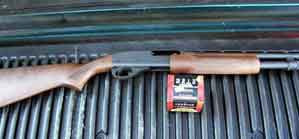
We obtained a Remington 870 Express 28-gauge shotgun for this experiment. While this reasonably priced model is a far cry from Cheney's high-end Perazzi-Brescia over-under 28-gauge, it is a fair enough facsimile for our purposes. We used shells loaded with ¾ oz. of No. 7 ½ shot, the identical size of shot that Cheney was using.
A note on chokes: The type of choke Cheney was using has been identified as a significant factor because it controls the gun's shot pattern and therefore impacts calculations of the distance at which it was fired. If the gun was fired at a close range, we don't think the choke type would matter, since at ranges closer than 20 yards the differences between the various chokes starts to disappear, and at a very close range of 15 feet, there is virtually no difference. The shot pattern doesn't start to widen until it has traveled some distance out of the barrel. Our gun was equipped with a fixed modified choke, which is somewhere in the middle of the range of chokes. Cheney was probably using a modified choke, an improved cylinder choke, or possibly an open cylinder (no choke). From modified to no choke there is a difference of about 20% density in the amount of shot delivered to a 30-inch circle at 30 yards.
After stocking up with a wide range of targets, from regulation police silhouettes to half a pig, we enlisted an experienced hunter and marksman, went to an undisclosed location, and began blasting away. We fired at a variety of targets for experimental purposes, using paper silhouette targets to establish the blast pattern consistent with the accident, and homemade ballistics gel and poultry to establish the range at which the shot was fired. We then attempted to re-create the incident more accurately by firing on half a pig carcass, with and without clothing.
Background on the Accident
 The Texas Parks and Wildlife official accident report put the distance of the shooting at 30 yards. However, some hunters and others knowledgeable about firearms have questioned this, saying that the amount of shot that hit Whittington and the injuries he received were consistent with a shotgun discharge at a closer range. It basically comes down to two things: how many pellets hit him and how deep were his wounds? Unfortunately, the initial information released (or lack thereof) muddled both of these issues. Some media reported that Whittington was hit by 200 pellets, which would have been nearly the entire contents of a shotgun shell filled with 7 ½ shot. There’s also the question of whether the pellet that ended up in Whittington’s heart, causing a minor heart attack, got there by penetrating his ribcage deep enough to lodge in his heart, or got there by migrating through a blood vessel.
The Texas Parks and Wildlife official accident report put the distance of the shooting at 30 yards. However, some hunters and others knowledgeable about firearms have questioned this, saying that the amount of shot that hit Whittington and the injuries he received were consistent with a shotgun discharge at a closer range. It basically comes down to two things: how many pellets hit him and how deep were his wounds? Unfortunately, the initial information released (or lack thereof) muddled both of these issues. Some media reported that Whittington was hit by 200 pellets, which would have been nearly the entire contents of a shotgun shell filled with 7 ½ shot. There’s also the question of whether the pellet that ended up in Whittington’s heart, causing a minor heart attack, got there by penetrating his ribcage deep enough to lodge in his heart, or got there by migrating through a blood vessel.
If you look at photos of Whittington after his release from the hospital, it appears he has about a dozen small pellet wounds all across his face, and major bruising on his neck. So we were trying to estimate what firing distance would produce that sort of damage. But we also wanted to see if it was possible that Whittington had been struck close enough for a pellet to penetrate deep enough into his flesh to hit him in the heart.
Procedure and Results
Paper Police Silhouette Targets:
These are standard police silhouette targets on 3’ by 4’ paper. We used them to help establish the blast pattern and distance of the shooting. We aimed roughly at the upper right hand quadrant of the target, which is where Whittington received the majority of his injuries, according to the Texas Parks and Wildlife Hunting Accident Report. Note: For better visibility of the perforations from the pellets, we went into the digital images and added red to mark the holes.
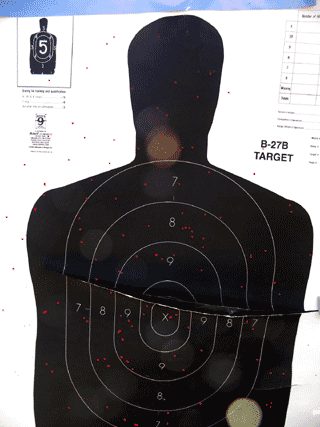
30 yards (90 feet)
Approximately 100 pellets hit the target over its torso area. The blast pattern was widely distributed over the target’s head and torso whether the gun was aimed squarely at the chest or slightly higher at the left shoulder. About 12 pellets hit the head and neck area.
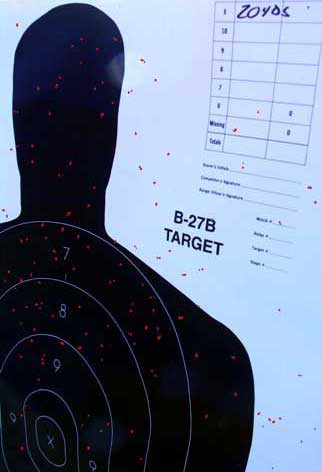
20 yards (60 feet)
Approximately 150 pellets hit the torso area of the target in a slightly more dense concentration. The pellets were focused in the upper torso area, but about two dozen pellets hit the head and neck area.
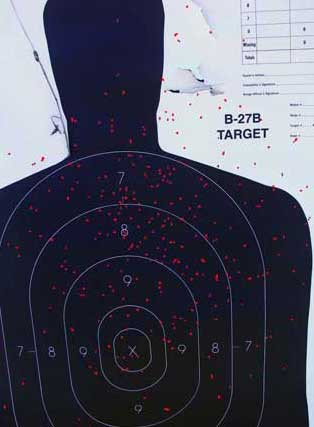
10 yards (30 feet)
Approximately 200 pellets hit the target torso, with most of the pellets concentrated in the left shoulder area. About 20 hit the face and neck.
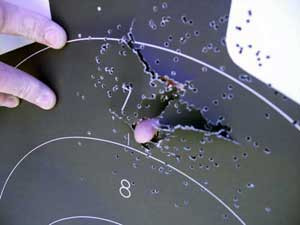
5 yards (15 feet)
All of the pellets hit the target within an area of about 8” in diameter in the upper left shoulder and neck area, and the shot blasted a hole clean through a sheet of ¼-inch plywood.
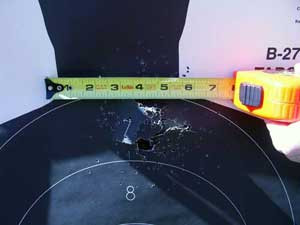
Summary: Close range shots produced a very tight and focused blast pattern on the paper targets. If Whittington had been hit at a range of 5 yards, the pellets that hit him would have been very densely concentrated within a hand-sized area. The blast patterns at 20 yards and 30 yards had a more even and wide distribution of pellets, which appears consistent with the number of wounds on Whittington’s face and their distribution.
Ballistic Gelatin:
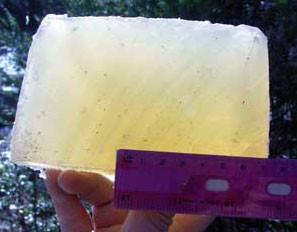
To help establish the range of the shooting, we made some blocks of homemade ordinance gelatin (see our special report on making ballistic gelatin). This is an approximation of the gelatin used by forensics experts to simulate living human tissue in ballistics tests. To calibrate the gelatin, we approximated laboratory procedures. We fired a .177mm BB directly into it and recorded the depth. The velocity of the test BB is supposed to be 590 fps; our gun fired at about 625 fps. Since it was a bit faster, the depth of penetration of the BB was 10 cm. That’s more than the ideal of 8.5 cm of penetration, but adjusting for the greater velocity, it’s reasonably in the ballpark. Although our ballistics gel wasn’t totally up to FBI forensics standards, it was fun to make and shoot. The results were pretty cool looking and the photos don’t really do them justice. We were impressed by how dense and resilient the stuff was, but we were also impressed by how a close range blast chewed it up.
We then fired into the blocks of gel from various distances
- 30 yards (90 feet) - Two pellets hit the 7.5 cm by 12 cm end of the gel block. The pellets penetrated to depths of 7 cm and 8 cm.
- 20 yards (60 feet) - Approximately 4 pellets hit the 7.5 cm by 12 cm end of the gel block. The pellets penetrated to depths of 6.5 cm to 8 cm.
- 10 yards (30 feet) - Approximately 15 pellets hit the 7.5 cm by 12 cm end of the gel block. The pellets penetrated to depths of 7 cm to 10.5 cm.
- 5 yards (15 feet) - Approximately 30 pellets hit the 7.5 cm by 12 cm end of the gel block. The pellets penetrated to depths of 5 cm to nearly 13 cm. No shot penetrated all the way through the 13 cm block, although one pellet came very close. One of the leading corners of the gelatin block was virtually shredded by the high concentration of pellets.
Summary: There was not much difference in depth of penetration between firing at 30 yards vs. firing at 20 yards. Firing at 10 yard and 5 yard ranges gave a higher concentration of pellets and up to twice the penetration at 5 yards. The 5-yard range was highly destructive to the gel.
Turkeys:
These turkeys were fully thawed and weighed about 15 pounds each.

30 yards (90 feet)
About two dozen pellets hit the turkey and punctured the flesh. In the photo, we have circled some of the strikes with marker for better visibility. The distribution of the pellets, spaced a few inches apart, resembles the distribution of shot wounds on Harry Whittington’s face. We were surprised by the depth that the pellets penetrated the turkey flesh. Despite cutting deeply into the flesh with a scalpel, we were unable to locate any of the pellets, which were buried deep in the flesh of the turkey breast. When we inserted a probe into an entry wound, we found it slid in easily for about 4 to 5 cm before meeting resistance.
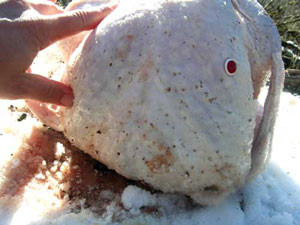
20 yards (60 feet)
The turkey was considerably more “peppered” at this range. The distance between pellets was less than an inch, and the turkey was hit by about 50 pellets. Again, they penetrated deeply into the flesh, leaving small clean wounds on the surface.

10 yards (30 feet)
Firing at a distance of 10 yards opened up a sizable gash in the turkey’s side, about 6 by 7 cm long and 7 cm deep.
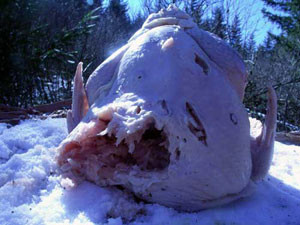
5 yards (15 feet)
Firing at close range not only tore this turkey open, it also lodged the shell’s plastic casing within the gaping wound. The hole was blown open about 12 cm wide and 12 cm deep.
(Watch the video)
Summary:
The pellets penetrated the turkey flesh pretty deeply, up to several cm, at distances of both 30 yards and 20 yards. The turkey caught about twice as many pellets at 20 yards as it did at 30. While shots fired at these distances produced small, clean wounds, firing at 10 yards and 5 yards ripped major “wounds” in the turkeys.
Cornish Game Hens:
These birds weigh 1.5 to 1.75 pounds each. They are about 4 times the size of quail, which average around 6 ounces each. These game hens, while already dead, are only slightly less lively and responsive than the slow, docile, and disoriented farm-raised “quailtards” that Cheney and Whittington were said to be hunting.
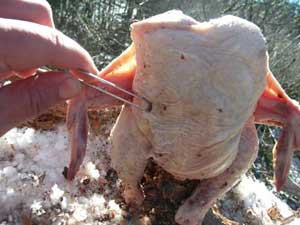
30 yards (90 feet)
At least a dozen pellets hit the game hen and penetrated all the way through the bird. We found a couple of pellets lodged just under the skin on the backside of the bird. This meant they traveled through 2 to 3 cm of flesh on the frontside, through the empty body cavity, and through about 1 cm of tissue on the backside.
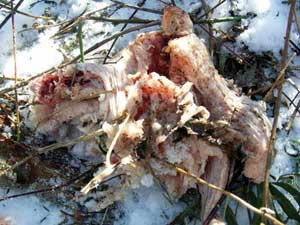
5 yards (15 feet)
This blew the bird clean off the stump. It went flying several feet and had flipped over before landing. We found it face down in the snow, and when we turned it over it looked like it had been filleted with a chainsaw.
(Watch the video)
Summary: There was significant pellet penetration at 30 yards, to the degree that the pellets traveled through the front and back side of the body cavity and almost through the back. At 5 yards the bird was completely ripped open.
Watermelon:
30 yards (90 feet)
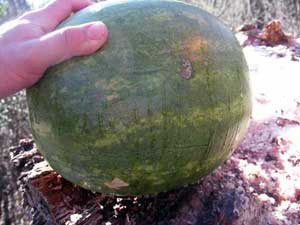
Approximately 30 pellets hit the watermelon, leaving small holes leaking watermelon juice. We broke the melon open to find them, and located pellets buried about 17 to 18 cm into the watermelon flesh. It appeared they had been stopped by the watermelon rind on the opposite side of the melon.
20 yards (60 feet)
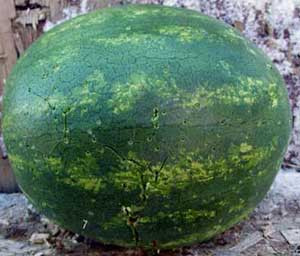
Approximately 60 pellets hit the watermelon, leaving small holes but also resulting in some cracking.
10 yards (30 feet)
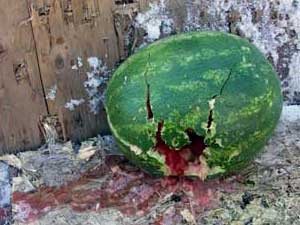
The blast left a large hole about 12 cm across. There was a cluster of pellet “exit wounds” on the backside and a cracked area several cm across.
Watch the Video
5 yards (15 feet)
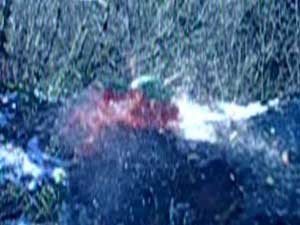
The watermelon was basically blown in half. We had set it on top of a stump and it just exploded into chunks, with the shot carrying away about half of the melon.
Honeydew Melon:
We took a shot at “Happy” the Honeydew Melon from a range of 5 yards. Needless to say, that wiped the smile right off Happy’s face, and we were left wiping what was left of Happy off our tree stump. There was little left of the melon but a green smear. The main portion of the melon carcass landed a few feet away. Fragments of melon were sprayed throughout a 15-foot radius, and our shooter reported he was struck by some of the backsplash.
Before

After

Watch the Video
Half a Pig:
We used an 80-pound half pig for our final demonstration. Ballistics labs use pork legs to simulate human flesh in test conditions. However, since the accident in question involved Whittington getting struck in the head and torso, we thought a half pig would produce more accurate results. To make the re-creation more authentic from a ballistics standpoint, we dressed the pig in clothing – a flannel shirt, lightweight vest, and denim pants. We added a festive Corona hat, but swapped it out for a more realistic blaze orange cap. The pig was propped up against the end of a log and was at a slight incline.
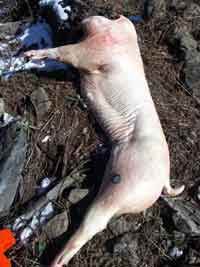
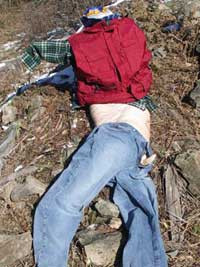
The first shot was fired squarely at the dressed pig from a distance of 30 yards. When we examined the carcass, we were surprised to find that virtually all of the pellets were stopped from penetrating the pork skin by the fabric of the clothing. Pellets made impressions in the denim of the jeans, and penetrated through the vest and shirt, but did not lodge in the skin. When we undressed the pig to examine the damage, several loose pellets rolled out from under the shirt. On an exposed area of the pig, we found one pellet that lodged about one millimeter into the skin. Although the skin was not broken, on the areas of the pig that were struck by shot, there was what appeared to be “bruising”, indicating trauma to the flesh under the skin.
We stripped the pig and fired at it again from the 30-yard distance. This time the pellets did lodge in the skin and flesh of the carcass. About a dozen pellets penetrated deep, going all the way through the skin and into the flesh. About 30 pellets lodged superficially in the flesh, which we should note is a lot tougher and leatherier than human skin.

30 yards
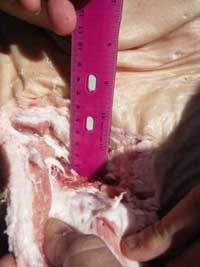
15 feet
We shot the pig again at a range of 5 yards. The blast pattern was identical to the one produced when we shot the paper target at 5 yards. The pellets were clustered in a radius of about 8 inches. Virtually all of them penetrated deep into the flesh. We cut into the carcass to see if we could locate some and found one buried at a depth of about 5.5 cm. We assume the others were buried as deep or much deeper.
Conclusions
Based on the shotgun spray patterns we observed and the various ballistics penetration tests we performed, we think that it is plausible that Whittington was shot at a distance of 30 yards and possibly as close as 20 yards. It seems unlikely that he was hit at close range.
Firing at 20 to 30 yards produced a broad pellet spray pattern that is consistent with the number and distribution of wounds on Whittington’s face. Our tests using poultry and the pig carcass showed that at 30 yards, pellets would have lodged in his flesh at least superficially and possibly have gone deeper into the tissue. If the pellet struck a bony area, say on his cheek or forehead, the bone would likely have stopped the pellet. Pellets that hit him from 30 yards and contacted areas of clothing would probably not have penetrated the skin, but would have left bruising.
All of this seems consistent with Whittington’s apparent injuries. This is what we speculate happened: Whittington was hit from 20 to 30 yards, either at an angle or from the side, or he caught just part of the blast pattern. The pellets hit him on the right side of his head, neck, and shoulder. The pellets that hit his face embedded in his skin. Hopefully he was wearing shooting glasses, or else he was damn lucky. (Remember what your mom told you about putting out an eye with your BB gun?) The pellets that hit his neck and shoulder were mostly stopped by his clothing, but left some serious bruising which is apparent in photographs.
We think it is unlikely that Whittington was hit at a very close range like 5 yards. First of all, if he was that close, the pellets that struck him would have been clustered together in an area several inches in diameter. They wouldn’t have spread out enough to produce the “peppered” effect of the dozen or so pellets scattered across the side of his face. Second, he would have had a much grislier injury. We can see from his photographs and the bruising pattern that he was hit at least partly on his neck. At 5 yards, if he had caught even part of the blast in the throat, he would probably be dead. If he was hit directly at 5 yards and his clothing slowed down some of the pellets, he probably still would have had a mass of closely clustered penetration wounds. Even if he did happen to catch a few stray pellets, if they contacted bare flesh, they would have gone in very deeply. Based on our test, even a distance of 10 yards would have produced more damage than he sustained. Of course, we are assuming that Cheney was using some type of choke in his gun. If he was not, the pattern at 5 yards might have spread out another foot or so, but it would still be pretty focused and the penetration of the pellets would be comparably deep.
As for the estimate that he was hit by 200 pellets, that figure may just have been derived from the number of pellets in a ¾ oz. shell of 7 ½ shot, which is about 262. However, if Whittington got hit from the side or at an angle, it’s possible he could have caught up to 200 pellets, with the majority landing on clothed areas and not penetrating deeply. It’s certainly not out of the question that he could have been hit by more than 100 pellets, but most of them did not cause serious injury.
Our conclusions also assume that his heart attack was caused by a pellet that somehow migrated to his heart, rather than one that was shot directly through his clothing, skin, and ribcage and lodged inside of his chest. We think our tests show that such a scenario would require being shot at a very short range, and such an impact would almost certainly have been fatal.
In summary, our results suggest that the media reports on the distance of the shooting and the number of pellets that hit Whittington are plausible. It’s possible that he was hit at a slightly closer range, up to 20 yards, but we think that if the distance was closer than 15 yards, the Whittington’s injuries would have been more severe and the outcome of the accident would have been much more dramatic.
Related article:
How to Make Your own Ballistics Gel
Other experiments:
How Many Condoms Can You Wear at Once?
Does Viagra Keep Flowers from Wilting?
How To Keep Beer Cold
The Cheney Shotgun Experiment
What is the Ultimate Jello-Shot?
How to Light a Jell-O Shot on Fire